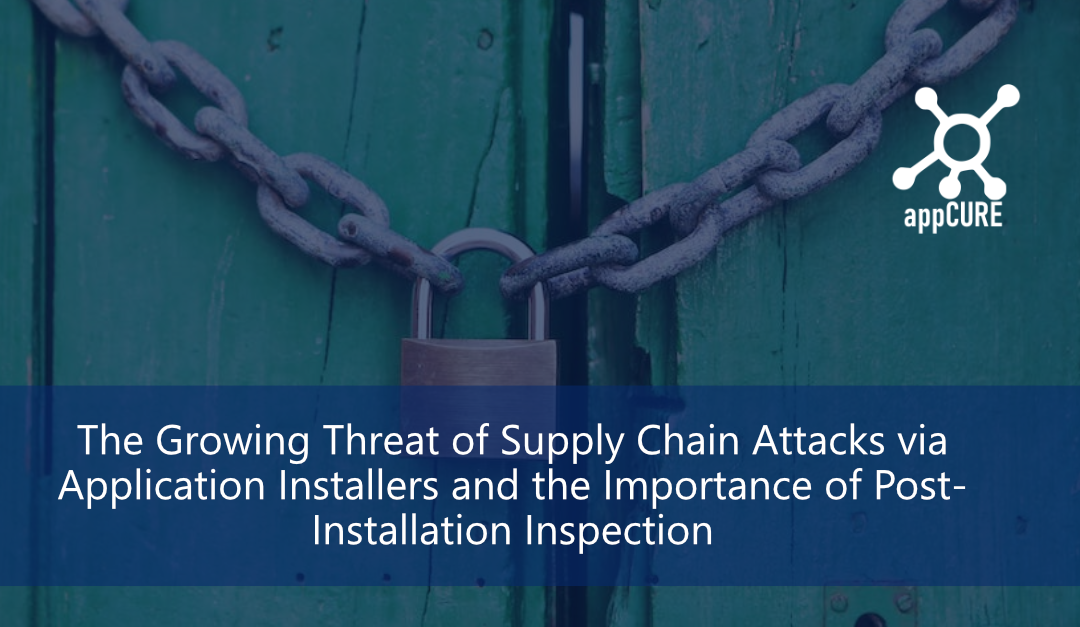
The Growing Threat of Supply Chain Attacks via Application Installers and the Importance of Post-Installation Inspection
Introduction
In recent years, there has been a significant increase in supply chain attacks targeting software applications from reputable vendors. These attacks exploit vulnerabilities in application installers to infiltrate networks and systems, potentially causing catastrophic damage. As the risk of such attacks continues to rise, organisations should prioritise inspecting applications and their post-installation behaviours to mitigate the threats posed by phase 2 and 3 attacks. This article will delve into the importance of reviewing all application packages from vendors before releasing them to production environments. Only recently, 3CX, a popular software-based phone system company, was subject to a supply chain attack.
The Rise of Supply Chain Attacks
Supply chain attacks are malicious attempts to compromise third-party software components or services in order to gain unauthorised access to a target system. These attacks have become increasingly popular among cybercriminals as they can bypass traditional security measures by exploiting trusted relationships between software vendors and their customers. Application installers from reputable vendors are particularly attractive targets, as they can easily infiltrate a system without raising suspicion.
Phase 2 and 3 Attacks: The Hidden Dangers
Phase 2 and phase 3 attacks refer to the stages of a multi-stage cyberattack that follows an initial compromise in a supply chain attack. While these terms are not industry-standard terminology, they help illustrate the progressive nature of advanced cyberattacks. Here’s a breakdown of the different phases:
- Phase 1 – Initial Compromise: The first phase typically involves the attacker compromising a third-party software or service, such as an application installer from a reputable vendor, to gain access to the target system. In supply chain attacks, this is achieved by exploiting vulnerabilities in the software or by inserting malicious code into the software package.
- Phase 2 – Establishing Persistence: Once the attacker has gained access to the target system, the second phase involves establishing persistence within the network or system. This can include deploying additional malware, creating backdoors, or leveraging legitimate tools and services to maintain a foothold in the compromised environment. During this phase, the attacker works to avoid detection and strengthen their position within the target system.
- Phase 3 – Lateral Movement and Execution: In the third phase, the attacker seeks to expand their access within the compromised system, moving laterally through the network and potentially compromising additional systems. This phase also involves the execution of the attacker’s primary objectives, such as exfiltrating sensitive data, deploying ransomware, or causing disruption to the target organisation’s operations.
By understanding the progression of these attacks, organisations can better defend themselves against the threats posed by supply chain attacks and other advanced cyber threats. Monitoring and inspecting applications and their behaviours, particularly post-installation, can help identify and mitigate risks associated with phase 2 and 3 attacks.
Inspecting Applications and Their Behaviours Post-Installation
- To mitigate the risk of phase 2 and 3 attacks, it is crucial to inspect applications and their behaviours post-installation. Organisations should consider implementing the following steps:
- Perform a thorough analysis of the application’s source code, configuration files, and dependencies to detect any potential vulnerabilities or malicious components.
- Monitor the application’s runtime behaviour to identify any unusual or unexpected actions, such as unauthorised network connections, file manipulation, or privilege escalation.
- Employ behaviour-based detection tools and security solutions that can automatically flag suspicious application activities.
- Regularly update software and apply security patches to minimise the attack surface and prevent exploitation of known vulnerabilities.
Reviewing All Application Packages Before Production Release
Given the growing prevalence of supply chain attacks, organisations must review all vendor application packages before releasing them to production environments. This process should include:
Verifying the integrity of the application package by checking digital signatures, hashes, and certificates to ensure the software has not been tampered with.
Employing sandboxing techniques to test and analyse the application in an isolated environment safely. This allows organisations to observe the application’s behaviour without risking the security of their production systems.
Conduct regular security audits of vendors and their software development processes to assess the potential risks and ensure adherence to security best practices, like ISO27001. This helps maintain a high level of trust and confidence in the software being delivered.
Establishing a security-focused mindset within the organisation, emphasising the importance of constant vigilance and collaboration between IT, security, and development teams. This can help ensure that security considerations are taken into account throughout the software development lifecycle and in the deployment of applications.
Conclusion
As the risk of supply chain attacks using application installers from reputable vendors continues to rise, organisations must prioritise inspecting applications and their post-installation behaviours to reduce the likelihood of phase 2 and 3 attacks. By thoroughly reviewing all application packages before releasing them to production and maintaining a proactive security posture, organisations can significantly reduce the potential damage caused by these increasingly sophisticated attacks. Implementing a comprehensive approach to software security, including sandboxing techniques, regular vendor audits, and fostering a security-focused culture within the organisation, will help mitigate the risks associated with supply chain attacks and protect valuable assets and data.
References:
(1) Gallagher, S. (2023, April 3). False Positive or the Real Deal? 3CX Supply Chain Attack Raises Questions. The Register. Retrieved from https://www.theregister.com/2023/04/03/3cx_false_positive_supply_chain_attack/
(2) Jackson, M. (2023, April). What Went Wrong with the 3CX Software Supply Chain Attack and How It Could Have Been Prevented. Security Boulevard. Retrieved from https://securityboulevard.com/2023/04/what-went-wrong-with-the-3cx-software-supply-chain-attack-and-how-it-could-have-been-prevented/
(3) Anderson, J. (n.d.). Kaseya Supply Chain Attack: What You Need to Know. Expel. Retrieved from https://expel.com/blog/kaseya-supply-chain-attack-what-you-need-to-know/
(4) International Organization for Standardization (ISO) & International Electrotechnical Commission (IEC). (2013). ISO/IEC 27001:2013 – Information technology – Security techniques – Information security management systems – Requirements. Retrieved from https://www.iso.org/standard/54534.html
